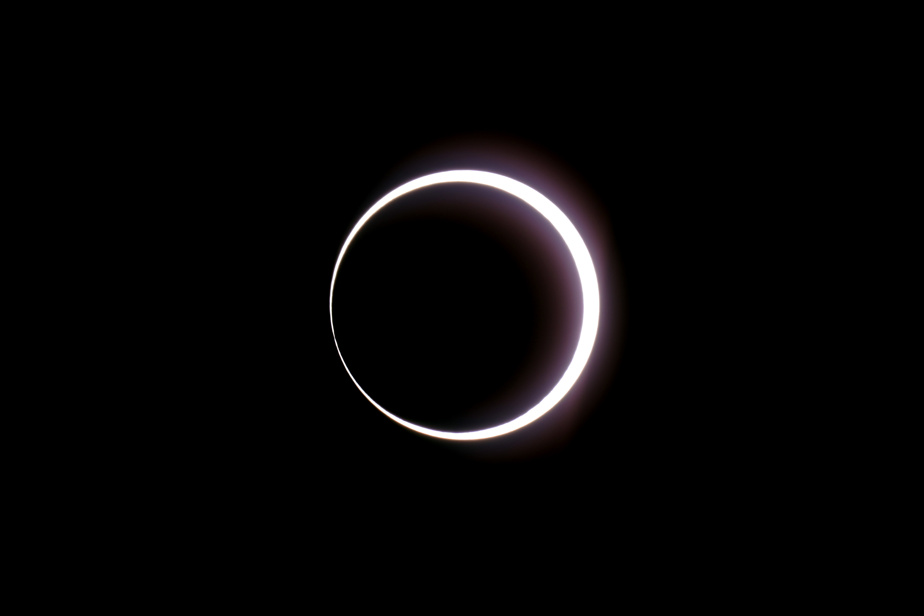(Albuquerque) Millions of people were able to watch an annular solar eclipse for the first time Saturday, with the moon covering the sun for several minutes and revealing a “ring of fire.”
Posted at 3:02 p.m
![]()
Gilles CLARENNE with Lucie AUBOURG in Washington Agence France-Presse
The eclipse should then be visible in several countries in Central and South America (Mexico, Colombia, Brazil, etc.).
During an annular solar eclipse, the Moon is slightly further away from Earth than during a total solar eclipse, and therefore from our perspective its diameter appears slightly smaller than that of the Sun – creating this orange “ring”.
The event is also a scientific opportunity for NASA, which wants to closely study changes in temperature and atmosphere.
In order to admire it, special certified glasses must be worn, even for those who are further from the optimal observation zone and therefore would only see a partial solar eclipse, emphasized the American space agency.
The solar eclipse was visible just after 9 a.m. local time (12 p.m. Eastern Time) in the US state of Oregon on the Pacific coast and crossed the United States from northwest to south until it appeared in the sky over South Texas almost half an hour later.

PHOTO LM OTERO, ASSOCIATED PRESS
The annular solar eclipse can be seen from Richardson, Texas.
At the same time, in Albuquerque, a large annual hot air balloon festival provided some sensational images.
This solar eclipse was “majestic,” described Shannon Cozad, who came to the festival and said it was “amazing.”
For Mubaraq Sokunbi, 8 years old, “it’s like some kind of black hole! “.
“The moon covers the sun and then there is a circle around it,” adds the boy who came to the festival with his family.
Residents of southwestern British Columbia had the best place to view this partial solar eclipse Saturday morning.
The eclipse began at 8:08 a.m. local time, peaked at around 9:20 a.m. and ended at 10:38 a.m. in Vancouver, although the weather forecast may have been disappointing for viewers.
Environment Canada predicted clouds and showers for much of southwestern British Columbia, where the moon obscured 70 to 80 percent of the sun.
This partial solar eclipse was also visible in Quebec “between 12:11 p.m. and 2:23 p.m.,” the Astronomical Society of the Planetarium of Montreal (SAPM) said on its website.
6.5 million on track
Unfortunately, clouds hovered over parts of Oregon and Texas, obscuring the phenomenon, according to the US National Weather Service.
In total, the solar eclipse could be observed in parts of eight American states.
The “ring of fire”, which corresponds to the circumference of the sun, lasts from a few tens of seconds to more than 5 minutes, depending on the observation location.
In the United States, “more than 6.5 million people live in the path of the eclipse,” NASA’s Alex Lockwood told a news conference. About 68 million people live within about 300 kilometers, or just a few hours’ drive, of the route, she added.
NASA broadcast a video program on its website with live broadcasts from New Mexico and Texas.
Sounding rockets
The event also served as a dress rehearsal ahead of a total solar eclipse over the United States scheduled for April 2024.
These two eclipses, the annular and the total, “will be absolutely stunning for scientific research,” said Madhulika Guhathakurta, a scientist in NASA’s Heliophysics Division.
“During a solar eclipse, there is a significant decrease in electron density in the ionosphere,” a layer of the atmosphere, she explained.
And “even though the atmospheric effects of solar eclipses have been studied for more than 50 years, many questions remain unanswered,” she emphasized. For example: “How much of the ionosphere is affected, for how long, and why is that?” »
NASA had prepared to launch three sounding rockets from the White Sands military base in New Mexico: one before the eclipse, one during and a final one after the event.
The goal: to collect data about the magnetic and electric fields, the electron density and the temperature that drops due to the moon’s shadow. This could also have destabilized the animals.
In 2017, the United States experienced a total solar eclipse. After the one in April, the next one will take place in the country in 2044.
There will also be a total solar eclipse in Spain in August 2026.
The Sun is about 400 times larger than the Moon, but also 400 times further away, which is why the two stars appear similar in size from Earth.
With the Canadian Press

